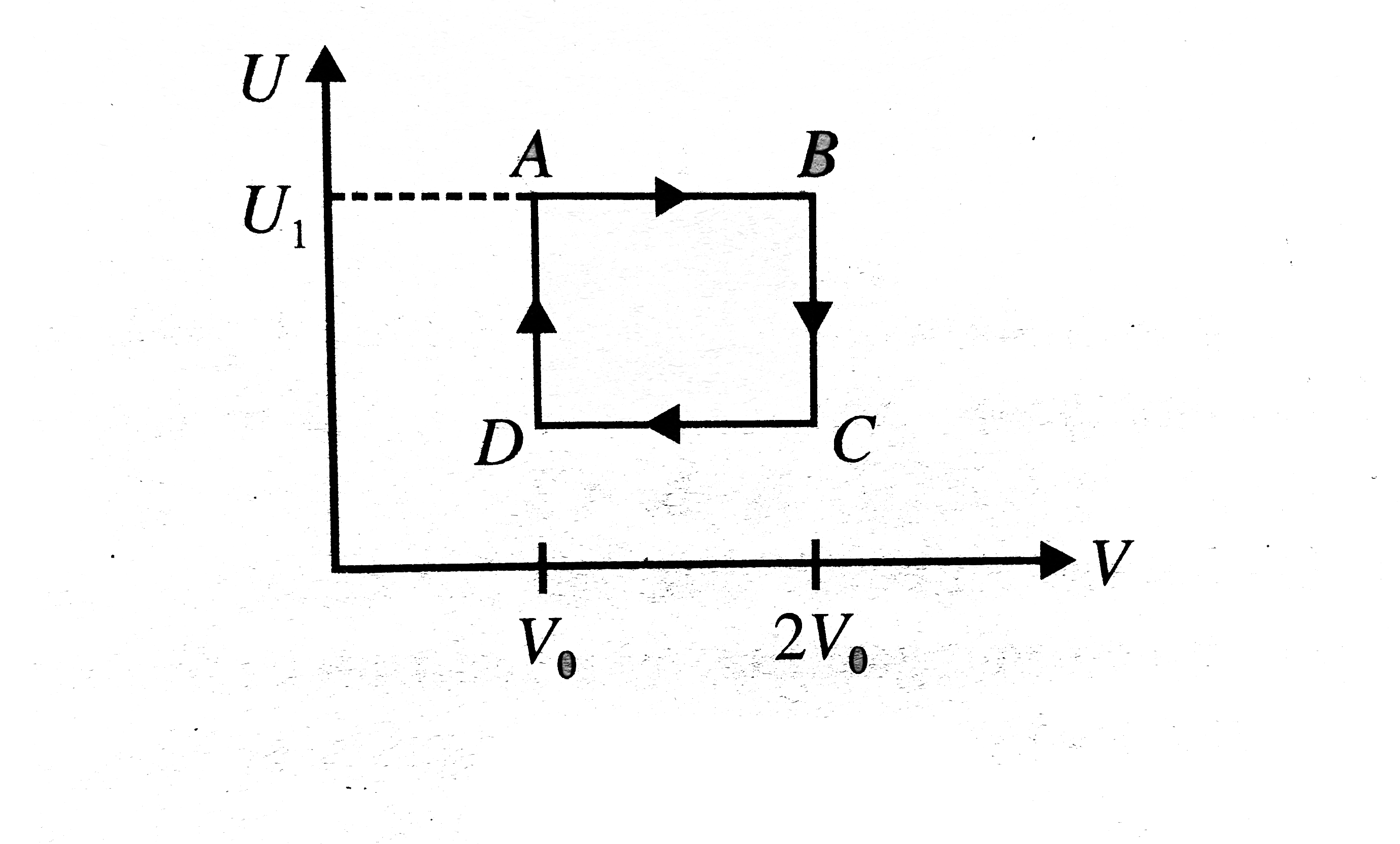For an ideal gas the molar heat capacity varies as C=CV+3aT2. Find the equation of the process in the variables (T,V) where a is a constant.
The correct Answer is:A, B, C
To solve the problem, we will follow these steps:
Step 1: Understand the given information
We are given that the molar heat capacity C of an ideal gas varies as:
C=CV+3aT2
where CV is the molar heat capacity at constant volume, a is a constant, and T is the temperature.
Step 2: Apply the First Law of Thermodynamics
According to the first law of thermodynamics:
dq=du+dw
For one mole of an ideal gas, we can express dq as:
dq=CdT
The change in internal energy du can be expressed as:
du=CVdT
And the work done dw can be expressed as:
dw=PdV
Substituting these into the first law gives:
CdT=CVdT+PdV
Step 3: Substitute the expression for C
Substituting C into the equation:
(CV+3aT2)dT=CVdT+PdV
This simplifies to:
3aT2dT=PdV
Step 4: Use the Ideal Gas Law
From the ideal gas law, we know:
PV=nRT
For one mole of gas, this simplifies to:
P=RTV
Substituting this into our equation gives:
3aT2dT=RTVdV
Step 5: Rearrange the equation
Rearranging the equation, we have:
3aT2dT=RTVdV
This can be rewritten as:
3aT2RdT=dVV
Step 6: Integrate both sides
Now, we will integrate both sides:
∫3aT2RdT=∫dVV
The left side integrates to:
3aR⋅T33=aT3R
The right side integrates to:
lnV
Thus, we have:
aT3R=lnV+lnD
where D is a constant of integration.
Step 7: Simplify the equation
Using properties of logarithms, we can rewrite this as:
aT3R=ln(DV)
Exponentiating both sides gives:
DV=eaT3R
or
V=eaT3RD
Step 8: Final form of the equation
We can express this as:
Ve−aT3R=constant
Conclusion
The equation of the process in the variables T and V is:
Ve−aT3R=constant
We are given that the molar heat capacity C of an ideal gas varies as:
C=CV+3aT2
where CV is the molar heat capacity at constant volume, a is a constant, and T is the temperature.
According to the first law of thermodynamics:
dq=du+dw
For one mole of an ideal gas, we can express dq as:
dq=CdT
The change in internal energy du can be expressed as:
du=CVdT
And the work done dw can be expressed as:
dw=PdV
Substituting these into the first law gives:
CdT=CVdT+PdV
Substituting C into the equation:
(CV+3aT2)dT=CVdT+PdV
This simplifies to:
3aT2dT=PdV
From the ideal gas law, we know:
PV=nRT
For one mole of gas, this simplifies to:
P=RTV
Substituting this into our equation gives:
3aT2dT=RTVdV
Rearranging the equation, we have:
3aT2dT=RTVdV
This can be rewritten as:
3aT2RdT=dVV
Now, we will integrate both sides:
∫3aT2RdT=∫dVV
The left side integrates to:
3aR⋅T33=aT3R
The right side integrates to:
lnV
Thus, we have:
aT3R=lnV+lnD
where D is a constant of integration.
Using properties of logarithms, we can rewrite this as:
aT3R=ln(DV)
Exponentiating both sides gives:
DV=eaT3R
or
V=eaT3RD
We can express this as:
Ve−aT3R=constant
The equation of the process in the variables T and V is:
Ve−aT3R=constant
Topper's Solved these Questions
- LAWS OF THERMODYNAMICSBOOK - DC PANDEY ENGLISHCHAPTER - LAWS OF THERMODYNAMICSEXERCISE - Level 2 Passage II
3 Videos
- LAWS OF MOTIONBOOK - DC PANDEY ENGLISHCHAPTER - LAWS OF MOTIONEXERCISE - Medical entrances gallery
39 Videos
- MAGNETIC EFFECT OF CURRENT AND MAGNETISMBOOK - DC PANDEY ENGLISHCHAPTER - MAGNETIC EFFECT OF CURRENT AND MAGNETISMEXERCISE - Integer type Questions
10 Videos
Similar Questions
Knowledge Check
For an ideal gas the equation of a process for which the heat capacity of the gas varies with temperatue as C=(α/T(α) is a constant) is given by
AVlnT=constantBVT1/(γ−1)_(e)α/RT=constantCV1γ−1Tα/RT=constantDVγ−1T=constant
An ideal gas has a molar heat capacity Cv at constant volume. Find the molar heat capacity of this gas as a function of its volume V, if the gas undergoes the following process :
(a) T=T0eαv ,
(b) p=p0eαv,
where T0,p0, and α are constants.
View SolutionAn ideal gas has an adiabatic exponent γ. In some process its molar heat capacity varies as C=α/T,where α is a constant Find :
(a) the work performed by one mole of the gas during its heating from the temperature T0 to the temperature η times higher ,
(b) the equation of the process in the variables p,V.
View SolutionThe molar heat capacity of an ideal gas in a process varies as C=CV+αT2 (where CV is mola heat capacity at constant volume and α is a constant). Then the equation of the process is
View SolutionFor certain process the molar heat capacity of an ideal gas is found to be (Cv+R2) , where Cv is the molar heat capacity of the same gas at constant volume. For the given process, it can be concluded that
View SolutionAn ideal gas is made to undergo a process T=T0eαV where T0 and α are constants. Find the molar specific heat capacity of the gas in the process if its molar specific heat capacity at constant volume is Cv. Express your answer as a function of volume (V).
View SolutionFind the value of molar heat capacity for an ideal gas in an adiabatic process.
View SolutionOne mole of an ideal gas has an internal energy given by U=U0+2PV , where P is the pressure and V the volume of the gas. U0 is a constant. This gas undergoes the quasi− static cyclic process ABCD as shown in the U−V diagram. The molar heat capacity of the gas at constant pressure is

View Solution
